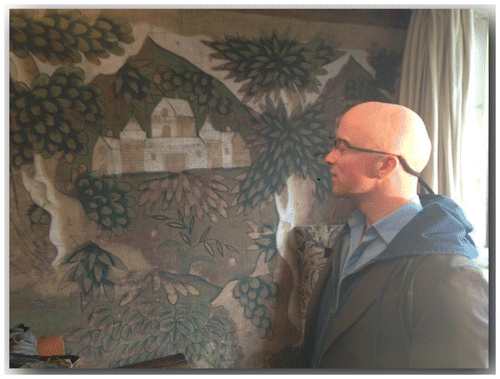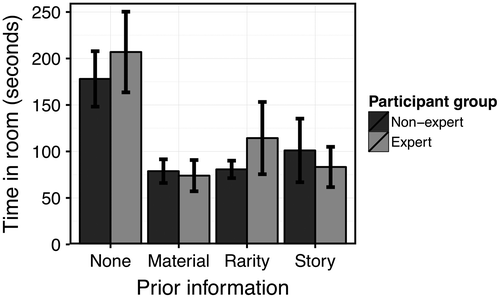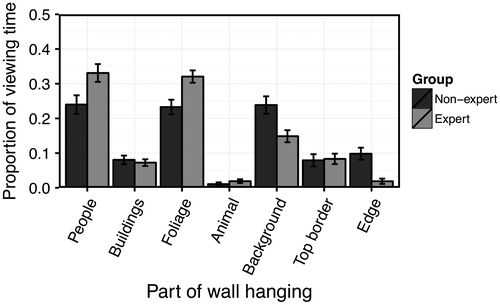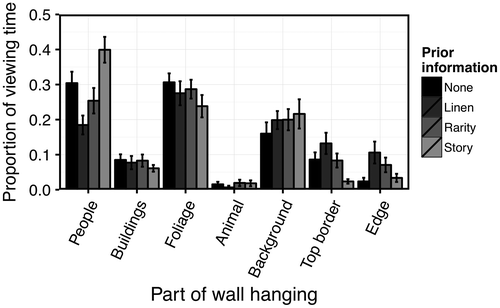Abstract
Decorative textiles were once ubiquitous and important, occupying a significant social and cultural space in the early modern interior, yet their impact upon how individuals engaged with domestic spaces is largely unknown. One way of approaching their impact is through an exploration of how present-day individuals engage visually with them in relation to other objects as they walk around an historic space. This article reports on one such investigation, an eye-tracking study which explored responses to the narrative hangings in Queen Margaret’s Chamber at Owlpen Manor in Gloucestershire. Using eye-tracking equipment, we compared the viewing behaviour of two groups of participants, to whom we gave key information before they entered the room. We found that both the expertise of the viewers and the information provided influenced their viewing behaviour. Our findings highlight the importance of individual understanding and information provided to viewers when engaging with historic spaces, and can inform museum and heritage practice as well as enhancing our comprehension of how viewers engage with such textiles in historic spaces.
Introduction
This paper presents the findings of a research study designed to help us understand the role of an important but traditionally overlooked category of early modern textile (painted cloths) in a domestic setting.Footnote1 The experiment formed a core part of the activities of an Arts and Humanities Research Council (AHRC) Research Network, Ways of Seeing the English Domestic Interior, 1500–1700: The Case of Decorative Textiles (2012–2013), which aimed to exchange knowledge about historical artefacts and environments in answering a central research question: how did individuals experience and engage with the visual and material properties of the domestic interior in early modern England, and how might we analyse and represent those experiences in the present? Decorative textiles with pictorial imagery raise particular questions about the dynamics of perception between the narrative (reading), visual (form, colour) and material (texture) qualities of interiors, and this article investigates the contribution that approaches and technologies used in psychology and computer science can make to exploring those relationships. Using eye-tracking equipment to chart viewers’ behaviour, it assesses individuals’ responses to early modern textiles in the context of an historic house interior, Queen Margaret’s Chamber at Owlpen Manor, Gloucestershire. Our findings aim to engage historians of domestic textiles and museum and heritage practitioners who interpret, conserve, display and present them, as well as psychologists interested in perception.
Approaches to historic textiles in an academic and museum context tend to follow an art-historical model of interpretation, with analysis of technique and skill in relation to manufacture coupled with explication of subject matter as narrative. These approaches are not, however, sensitive to the peculiar qualities of the medium as tactile fabric furnishing, introduced to enhance domestic living conditions, or the specificity of visual experience in relation to physical and interpretative contexts. New approaches are suggested by recent interest in material and visual culture; the interdisciplinary field of material culture has focused attention on the need to be attentive to the materiality of decorative objects, while studies in visual culture — with its emphasis on the various means by which ways of seeing are influenced by the social and cultural context of a given period, region or community — opens up questions about the relationship between the physiological act of seeing and the intellectual frameworks which condition perception. In order to achieve a richer understanding of how such textiles operated as part of the furnishings of homes as lived spaces, and therefore how they contributed to the experience of domestic interiors, it is now essential to engage with disciplines outside the humanities to develop some initial practical experiments.
The aim of this article — and of the experiment on which it is based — is to investigate how the configuration of a room and its furnishings influences strategies for viewing — where do people look and how long do they spend looking? More specifically, what can we learn about how people engage with historic textiles with a narrative component in a ‘real’ domestic environment? Would the nature of this engagement change when they were provided with specific pieces of information about the various qualities of the artwork? Using methods of analysis from social science disciplines makes it possible to provide a rigorous statistical underpinning for the role of these early modern decorative features, and to explore quantitatively how they functioned as part of an interior (the relationship between the different elements of a room). These empirical findings can then be brought into dialogue with more qualitative material, such as the evidence of the questionnaires the participants completed (which are analysed in the introduction to this special issue), and contemporary accounts of the way such interiors functioned, which are explored in several of the other papers in the issue. Such a scientific analysis also makes it possible to quantify the potential impact of display decisions. While some similar studies of viewer behaviour using eye-tracking technology have been conducted in the particular settings of museum galleries, they have mainly focused on the potential for eye tracking as a useful measure in gallery spaces, the technical limitations involved and overall proportions of navigation and looking.Footnote2 No comparable study to date has attempted to analyse how people view narrative decorative art and furnishings in the ‘real-world’ environment of a domestic room, or how such viewing might be influenced by prior knowledge and information given to viewers.
Owlpen Manor, Gloucestershire, was selected as the case study because one of the bedrooms (known as Queen Margaret’s Chamber) is decorated with a unique scheme of painted cloths dating from the early eighteenth century. Painted cloths were once an extremely common form of interior decoration across Europe and feature prominently in probate documents and account books. They were used to cover the walls of Tudor and Stuart interiors as insulation and decoration before the introduction of panelling and wallpapers.Footnote3 Very few examples of this art form survive and most are in a fragmentary condition. The rare survival of a complete scheme in good condition and in situ therefore provided an appropriate location for our study. The room also contained a standing bedstead, several large pieces of storage furniture and a variety of other smaller pieces including a screen, spinning wheel and a display case, all of different dates. Two stone-mullioned windows offered views across the Manor’s formal gardens, and gave natural light (Fig. ). This was supplemented by two spotlights on floor stands positioned near the same wall as the windows. The additional lighting was required in order to provide sufficient light for the videos recorded from the head-mounted eye-tracker equipment worn by participants to be analysed, but their position did not significantly alter the direction of the light (see the Appendix for more details).
Fig. 1. Queen Margaret’s Chamber, Owlpen Manor, Gloucestershire, with insets showing details of the contents and painted cloths, early eighteenth century.
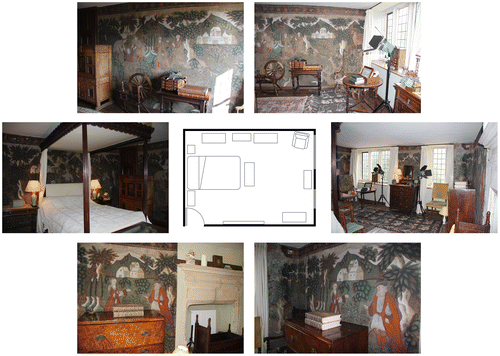
The cloths at Owlpen Manor are painted in distemper, a tempera technique where earth pigments are bound with glue size, on 42-inch unbleached canvas-linen strips. They depict a stylised landscape of conical hills, white buildings, flowers, foliage, cedars palms and other trees. Within this landscape setting are figures and animals representing three scenes from the biblical story of JosephFootnote4 (Fig. ). On the west wall (left of the fireplace) are two figures representing Joseph in his ‘coat of many colours’ with his father, Jacob. On the east wall opposite the entrance to the room is a scene showing Joseph being lifted out of the pit by two of his brothers, while to the right two Ishmaelite merchants approach with their camels. On the north wall behind the bed is a scene showing Joseph being sold to the Midianite traders for twenty pieces of silver, among some sheep and a sheep dog with a dove above. While the cloths are not original to the room, they were acquired (probably new) for another of Owlpen Manor’s rooms with similar dimensions, so that their current presentation retains a sense of their original scale, form and appearance as expansive wall coverings.Footnote5 The benefits of this case study also include the fact that the house is privately owned and still occupied as a home (so that the room is furnished with a combination of period and modern domestic items, unlike some museum contexts), and yet the chamber is also part of a suite of rooms on display during periods when the house is open to the public (so it is ‘styled’ to some extent for presentation to visitors, as would have been the case in the carefully furnished semi-public spaces of an early modern interior). This unusual combination of domestic and heritage setting helps to encourage the kind of self-conscious viewing practices which are associated with the early modern period.Footnote6
This paper opens with a discussion of viewing and perception before turning to the results of the study. The implications of the findings for historical and heritage analyses of decorative textiles in domestic settings are discussed in the conclusion, while the appendix provides a scientific discussion of the methods employed.
Current Research on Viewing and Perception
In order to understand the range of probable responses to domestic textiles, it is necessary to appreciate the nature of vision. The immediacy and omneity of our subjective visual experience belies the reality of seeing: despite our comprehensive and uninterrupted sense of seeing, the eyes interrogate our surroundings neither completely nor continuously. High-quality vision is restricted to a small area in the centre of where we are looking — an area about the size of a thumbnail when held at arm’s length. Beyond this region vision becomes increasingly blurry with distance from the centre (Fig. ). This restricted window of clear vision necessitates that we move our eyes in order to gather high-quality views of the world around us; we must point our high-resolution central vision at locations from which we need good-quality visual information. However, vision is poor when the eyes are moving — just as it takes time to expose a camera film to light and the camera must be held steady during this time in order to achieve a sharp image, so it takes time for the rods and cones in the retina to respond to light, and thus the eye must also be steadied for long enough to obtain a sharp image. The opposing requirements to move the eye in order to sample high-quality information, yet stabilise it in order to obtain clear visual images, have given rise to a particular strategy for gathering information from the world around us: we move our eyes in rapid jerks called saccades, during which we are essentially blind.Footnote7 These rapid movements are punctuated by ‘fixation pauses’ where the eyes are stabilised for an average of around a third of a second. It is during these fixation pauses that useful visual information is sampled. This staccato sampling of the world is thus very unlike our subjective impression of seeing.
Fig. 2a. Despite how it feels, clear vision is restricted to a small region in the centre of where we look. Vision becomes increasingly blurry with distance from the centre.
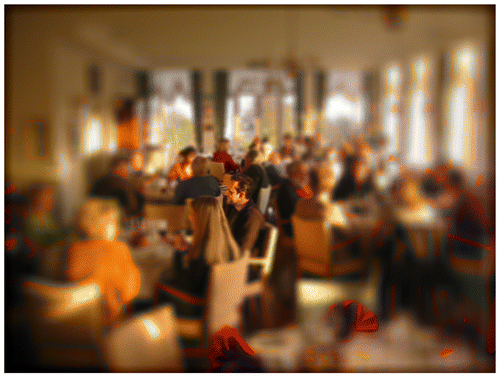
With each fixation lasting an average of around a third of a second, we can only direct our high-resolution central vision to about three or four locations in every second. As a result, we cannot realistically direct this small window of clear vision to everything within a scene — indeed, the small central region covers only around 0.03 per cent of our surroundings, and so to stand in one location and direct the eyes such that the entire visual environment is sampled at the highest resolution would take around sixteen minutes.Footnote8 Unsurprisingly, therefore, visual sampling is selective rather than exhaustive: we do not attempt to sample every location at the highest resolution but instead direct the eyes selectively to particular locations in scenes (Fig. ). Not only are we selective about where we look, but it seems that this selectivity is underpinned by factors common across people. Indeed, when several people are shown the same image, there are locations that most people look at and others that few look at.Footnote9 The question then arises as to what common underlying factors might be responsible for the similarities in viewing behaviour across people. This question has been at the heart of psychological inquiry since the manner in which we move our eyes was first objectively recorded, and continues to underlie contemporary research.Footnote10
Fig. 2b. Eye-movement behaviour of an individual viewing a photograph of the interior of an office building. Dots indicate locations at which the eyes paused for periods of fixations, lines indicate the eye movements that brought the eye to each location. Viewing is highly selective. Figure adapted from B. W. Tatler, M. Hayhoe, M. Land and D. H. Ballard, ‘Eye guidance in natural vision: reinterpreting salience’, Journal of Vision, xi, no. 5 (2011), pp. 1–23.
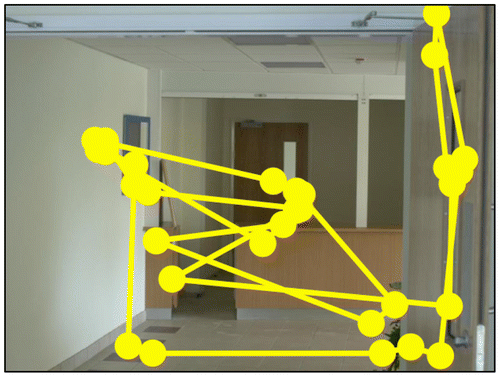
The strict spatial and temporal sampling limits on vision mean that successfully completing many tasks requires that we look at the right place at the right time in order to gather the information that we require for our behavioural goals. Thus, if we can understand when and where we look, we can understand not only the visual input to the brain that is used for planning and executing our behaviours, but also the moment-to-moment information requirements and strategies employed by the brain in order to gather the required information. Eye movements, therefore, reveal key insights into the manner in which behaviour and cognitive processes are organised and prioritised in the brain.
Two opposing factors seem to play a role in deciding where we look: the properties of the scene and the goals of the observers while looking. It is clear that the properties of a visual stimulus in part shape our viewing behaviour,Footnote11 and there is a correlation between where we look and the most visually conspicuous locations in scenes (those that differ most from their surroundings in terms of colours, brightness and contrast).Footnote12 Given that visual conspicuity is defined by physical properties in the stimuli we view, different people should look in similar places in scenes, and indeed this is broadly the case.Footnote13 However, the correlations between where we look and the most visually conspicuous locations in scenes are typically weak,Footnote14 and less important than the goals of the observer — why they are viewing the scene will play a larger part in determining the direction of their gaze. The importance of such ‘task goals’ in deciding where we look has been recognised since some of the earliest recordings of eye movements were made,Footnote15 and the notion that the instructions we receive before viewing a stimulus can have a profound influence on how we view the stimulus was demonstrated elegantly by both Guy Buswell and Alfred Yarbus.Footnote16 Yarbus recorded the eye-movement behaviour of a single participant viewing a copy of Ilya Repin’s painting The Unexpected Visitor (1884) seven times, each time with a different instruction prior to viewing. The participant’s viewing behaviour was markedly different each time and the locations fixated corresponded to those that might be expected to provide information relevant to the task suggested by the instructions (Fig. ), showing that our goals — which can be set by the instructions we receive — have a profound influence on where we look.
Fig. 3. Recordings of one participant viewing Ilya Repin’s painting The Unexpected Visitor (1884) seven times, each with different instructions prior to viewing. Each record shows eye movements collected during a three-minute recording session. The instructions given were: (a) Free examination. (b) Estimate the material circumstances of the family in the picture. (c) Give the ages of the people. (d) Surmise what the family had been doing before the arrival of the unexpected visitor. (e) Remember the clothes worn by the people. (f) Remember the position of the people and objects in the room. (g) Estimate how long the unexpected visitor had been away from the family. Illustration adapted from A. L. Yarbus, Eye Movements and Vision (New York: Plenum Press, 1967), fig. 109, for M. Land and B. W. Tatler, Looking and Acting: Vision and Eye Movements in Natural Behaviour (Oxford: Oxford University Press, 2009), p. 43.
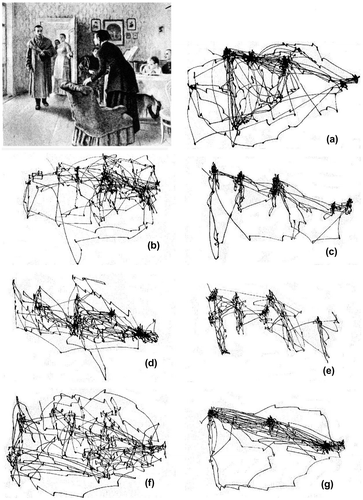
The information and knowledge that we bring to any situation also influences where we look. This knowledge may come from our previous experience and expertise as well as from information that we are given at the time of viewing a stimulus.Footnote17 Experts in a range of tasks show different eye-movement behaviour from non-experts:Footnote18 expert chess players, for example, look at the spaces between playing pieces on a chess board, whereas novice players look at the individual pieces;Footnote19 as radiographers learn to find cancers in X-ray images, so their eye-movement strategies change.Footnote20 While differences in eye movements can act as reliable markers for expertise, it is not always clear whether or how they reflect variances in the underlying processes occurring during fixations, such as information processing style.
Viewing behaviour can be altered by the information given immediately prior to viewing a stimulus. When viewing abstract art, knowing the title of a piece can influence both inspection behaviour and understanding: Kapoula, Daunys, Herbez and Yang found that observers inspected cubist paintings by Fernand Léger (The Wedding, The Alarm Clock and Contrast of Forms) differently when they were told the title of the piece before viewing than when they were given no information prior to viewing.Footnote21 Collectively, these studies demonstrate that viewing behaviour is influenced by both prior knowledge and any information provided immediately before viewing a stimulus. Thus we might expect similar factors to influence how people view decorative textiles within domestic spaces.
Viewing behaviour is also influenced by the context in which we view a stimulus. Laboratory-based viewing paradigms, where images of objects or scenes are displayed on computer screens, offer the opportunity for experimental control over the viewing conditions, but may not reflect how we view real environments, or objects in the context of real environments.Footnote22 In particular, the frame of the monitor provides a frame of reference not present in the real world, and results in a strong tendency to fixate the centre of the screen irrespective of the content of the viewed scene.Footnote23 Removing objects from the context in which they would naturally be viewed can have important consequences for how they are viewed. For example, viewing early Renaissance paintings under modern lighting conditions results in changes in the appearance of the gold leaf that is common in many of these paintings, which appears to glow if viewed when illuminated by beeswax candles, and indeed this changes the manner in which the paintings are viewed.Footnote24 The manner in which we understand, represent and remember the objects and environment can also vary considerably between laboratory and natural contexts.Footnote25 If we are to understand how environments and the objects within them would be viewed and understood by participants, it is therefore important to study this behaviour in a context that matches the real-world situation as closely as possible.Footnote26
The Present Study
In order to analyse how people view decorative textiles within historic domestic interiors, given the dependence of viewing behaviour on the context in which a stimulus is viewed and the considerable differences in how we view, represent and remember images, we recorded participants’ eye-movement behaviour while they explored Queen Margaret’s Chamber at Owlpen Manor.
Selecting a single environment necessarily limits the scope of the findings. From a practical perspective, the time required to analyse data collected from mobile eye-tracking equipment is considerable, with manual frame-by-frame coding required for the video records of where observers looked (indeed, psychology studies of real-world viewing behaviour typically use relatively few participants).Footnote27 However, this case study approach, not uncommon in psychology experiments, does have particular advantages: it enabled us to explore viewing behaviour in detail, considering how participants’ responses to particular motifs within the painted cloths related to their investigation of other aspects of the selected environment, thereby providing a detailed description of a single case study rather than more general descriptions across a variety of settings which would not have allowed us to assess our key questions of narrative structure in sufficient detail.
This case study provides a timely collaboration between traditionally distinct research fields and offers, we hope, novel insights across these disciplines. From the perspective of the psychology of vision, there are no existing empirical studies of eye-movement behaviour for viewing an entire room as people walk around a real-world environment and view pictorial art in a domestic context. Moreover, the fact that the pictorial information in the painted cloths encompasses the extended space of an entire wall and indeed extends around all four walls of the room, offers insights into how we view pictures that are not bounded by artificial frames like those provided by a computer monitor. Our study is also the first study of real-world vision in which the effects of different sets of instructions prior to entering an environment have been compared, enabling insights into the quantitative effects of instructions upon viewing behaviour in a natural setting.
Studies of early modern domestic interiors, on the other hand, have not yet sought to understand the relative significance of objects in a visual way, nor investigated fully how narrative might operate spatially in rooms of this period.Footnote28 There has been very little work on spatial experience, despite the obvious connections between this kind of immersive work and the analysis of early modern theatrical performance cultures,Footnote29 and current scholarship does not take into account the visual and aesthetic ways in which information is gleaned in the early modern interior, or the relationships between aesthetics, narrative, and the social and cultural meanings of space.
In order to consider the impact of prior knowledge on viewing behaviour, we compared viewing for participants with different levels of familiarity with the roles of decorative textiles in historic interiors. We recruited two distinct groups of participants: one comprised members of the AHRC-funded network on ‘Ways of Seeing the English Domestic Interior, 1500–1700: The Case of Decorative Textiles’. These participants came from a variety of disciplines and had varied prior knowledge, but all were engaged with heritage and, as network members, had knowledge of the social and cultural significance of decorative textiles in properties contemporary with Owlpen Manor. The second group of participants comprised undergraduate and postgraduate student volunteers enrolled on humanities programmes. This group had not been informed about the social and cultural significance of decorative textiles and were given no prior information about the identity of the house they would visit or the nature of its interiors. By comparing these two groups we were able to consider whether and how knowledge of the importance of decorative textiles influences the manner in which an historic space is explored.
In order to consider how the information given to participants before entering the domestic interior shapes inspection behaviour, we asked each participant to enter and explore the same room four times. No information was given to any of the participants prior to the first entry. They were simply instructed to look around and explore the room. The three subsequent entries were preceded by providing the participant with a brief written statement about the room, designed to highlight particular pieces of information about the painted cloths. These statements highlighted the materials from which the cloths were made (‘The hangings are made from linen’), the rarity of the painted cloths (‘The hangings on the walls are very rare, dating from about 1700’) and the story illustrated within the painted cloths (‘Depicted within the hangings is the story of Joseph and his brothers from the Bible’). The order in which the participants received these three statements was counterbalanced across participants in order to control for any order effects on viewing behaviour.
Participants’ eye movements were tracked using one of two Positive Science LLC mobile eye trackers, which allowed free head movement. Each tracker has two cameras mounted on the frame of a pair of spectacles (Figs and ): one records the scene from the participant’s point of view (scene camera), the other records movements of the right eye (eye camera). After the experiment, eye-tracking data were manually coded offline by the authors and two volunteer research assistants. Eye movements (saccades) were detected manually using deflections of the iris in the video overlay of the eye in the eye-tracking video. The eye-tracking information was analysed using ‘analyses of variance’, or ANOVA, which allowed us to quantify whether and how prior knowledge and information given to participants changed behaviour in the room and whether the effects of providing differing instructions were different in the two groups of participants. A fuller discussion of the methods adopted in this experiment is offered in Appendix 1.
Fig. 4b. A frame from the rendered movie, combining the view from the participant’s head with the view of their eye (inset top right). A calibrated model of the eye was fitted in Yarbus software. The cross hair in scene shows where the centre of gaze was directed.
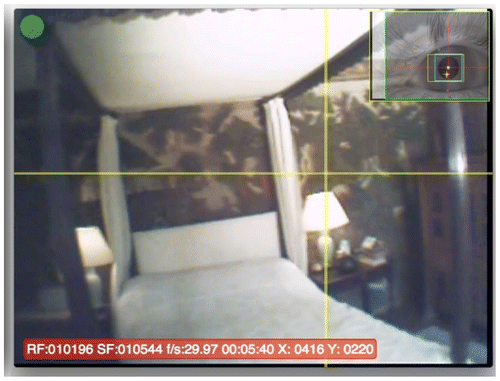
Results 1: Time Spent in the Room
As a measure of engagement with the room we first considered the amount of time that people spent within it.Footnote30 Participants were given no instructions about how long to spend there; they were told to stay for as long as they wanted to. There was no significant difference between the two groups of participants in how long they spent in the room.Footnote31 However, time spent in the room did differ according to the statement received prior to entry.Footnote32 Participants from both groups spent longer in the room on their first entry (with no specific instructions) than on any other entries to the room. The difference found between the first and later entries to the room was the same for the two groups of participantsFootnote33 (Fig. ). These results show that the background of the participants did not influence how long they spent in the room, and neither did the nature of the statement given prior to entry: whether it was about the material, rarity or story of the painted cloths.
Results 2: Viewing Behaviour in the Room
In order to consider how people inspected the room while in it, we recorded what each fixation was directed at during the first sixty seconds that they spent in the room (or for the entire duration of their time in the room if they spent less than sixty seconds inside it). We then assigned these fixations to one of nine categories of content within the room and calculated the proportion of time for which gaze was directed to each of these nine categories. Figure shows that the painted cloths, furniture and objects within the rooms were looked at far more than its other aspects (for example, architectural features). For this reason, we restricted our analysis to only these three categories of room content.
Fig. 6. Mean proportion of viewing time spent looking at each category of content in the room. Separate plots are shown for each of the four statements given before entering the room. Black bars show viewing behaviour by non-expert participants; grey bars show viewing behaviour for expert participants. Error bars show 1SEM.
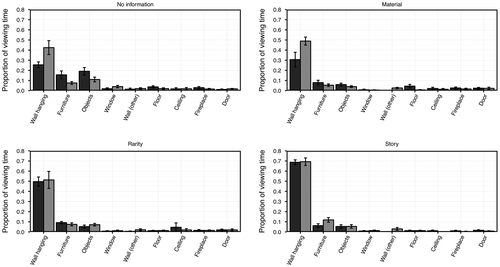
A 3-way ANOVA showed that allocation of gaze in the room varied between the four pieces of information given before entering the room and between the three categories of content. The differences in gaze allocation across the three categories of content in the room was different for expert and non-expert participants, and also varied depending on the statement read before entering the room. There was a significant three-way interaction between participant group, prior information and category of room content. This shows that the effects that different statements had on the distribution of attention around the room differed for the two groups of participants.Footnote34
If we consider only the first entry into the room, before which participants received no information about the room, participants who did not know about the social and cultural significance of decorative textiles in historic domestic interiors (our ‘non-expert’ group) were no more likely to spend time looking at the painted cloths than they were to spend time looking at the furniture and objects in the room.Footnote35 In contrast, participants who did have an understanding of the social and cultural significance of the decorative textiles (our ‘expert’ group) spent significantly more time looking at the painted cloths than they spent looking at other things in the room.Footnote36 This immediately demonstrates that what people already know about historic domestic interiors and the importance of their content shapes the manner in which they view the domestic interior. Furthermore, the lack of preference for painted cloths in our non-expert group suggests that, despite their prominence in the room, they do not inherently attract attention any more than do its other contents.
Two follow-up 1-way ANOVAs were run to explore the manner in which the prior information given before each room entry influenced the proportion of time spent on the painted cloths for participants in the expert and non-expert groups. Informing participants about the story within the painted cloths resulted in more time spent looking at these than after any other information given.Footnote37 Providing information about the rarity of the painted cloths resulted in more time spent looking at them than when no information was provided, but only for the expert group.Footnote38 Informing participants that the cloths were made of linen did not result in significantly longer looking times than providing them with no information before entering the room. Our findings therefore demonstrate that both the background knowledge of the participants and the information that they were provided with before entering the room influenced how much time was spent looking at the painted cloths relative to other things in the room. In the following section, we consider whether these factors also influenced the distribution of attention within painted cloths: that is, which parts of the painted cloths were looked at by our participants.
Results 3: Looking at the Painted Cloths
In this analysis we consider only fixations made to the painted cloths and whether participants looked at: people depicted in the cloths, buildings, foliage (trees and bushes), animals, background (hills, ground, sky), the border around the top of the painted cloths and the (vertical) edges of the cloths (see Figs and for examples of these components).
Fig. 7a. A section of painted cloth, Queen Margaret’s Chamber, Owlpen Manor, Gloucestershire, early eighteenth century.
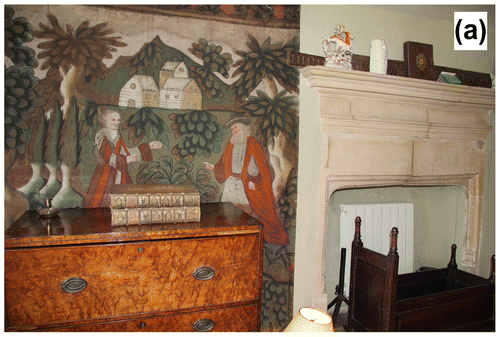
Fig. 7b. A section of painted cloth, Queen Margaret’s Chamber, Owlpen Manor, Gloucestershire, early eighteenth century, colour-coded by the regions used in our analyses for people (red), buildings (royal blue), foliage (green), top border (magenta), edge (brown) and background (sky blue).

A 3-way ANOVA revealed that attention was not allocated equally to all aspects of the painted cloths.Footnote39 These differences between the parts were modulated by the participant group, and by the prior information provided before entering the room.Footnote40 Figure 8a shows that certain motifs were looked at more by the participants with prior knowledge of the social and cultural significance of the painted cloths (the foliage and the people, although for the latter the result was not statistically reliable),Footnote41 whereas other parts of the painted cloths were looked at more by the participants who did not know about the historical significance of the painted cloths (the background and edges).Footnote42 Figure 8b shows that informing participants about the material resulted in more time spent looking at the top border and edge of the painted cloths and less time looking at the people; providing information about the story in the painted cloths produced the opposite effect.Footnote43
Results 4: Looking at Characters in the Painted Cloths
Finally, we considered whether the background of our participants and the information provided prior to viewing resulted in different allocations of attention to the characters within the painted cloths. The cloths show ten human figures (characters within the story of Joseph) around the room. We arbitrarily labelled these 1–10 according to the order in which they appear, moving clockwise around the room starting at the wall behind the bed (Figs –).
Fig. 9a. Painted cloth, Queen Margaret Chamber, Owlpen Manor, Gloucestershire, early eighteenth century, left-hand wall inside door.
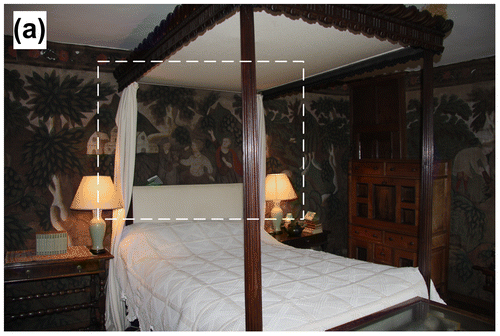
Fig. 9b. Human figures 1–3, Painted cloth, Queen Margaret’s Chamber, Owlpen Manor, Gloucestershire, early eighteenth century, detail, left-hand wall inside door.
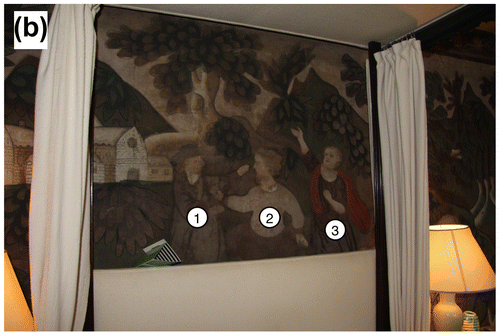
Fig. 9c. Human figures 4–8, Painted cloth, Queen Margaret’s Chamber, Owlpen Manor, Gloucestershire, early eighteenth century, wall facing door.
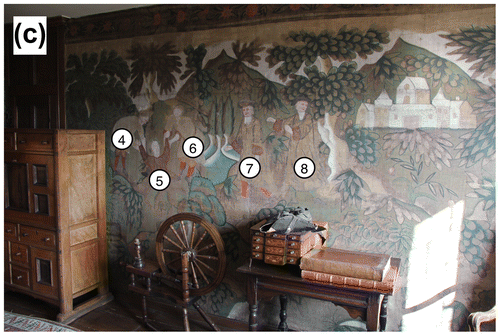
Fig. 9d. Human figures 9–10, Painted cloth, Queen Margaret’s Chamber, Owlpen Manor, Gloucestershire, early eighteenth century, right-hand wall from door.

A 3-way ANOVA revealed that not all of the ten characters received the same amount of viewing time.Footnote44 These differences across the characters were somewhat modulated by the information provided prior to entering the room, with an interaction between depicted character and prior information that approached significanceFootnote45 (Fig. ). This interaction, while not statistically significant, seems to suggest that character 10 was looked at more than any of the other people when given no instructions or when informed about the material or rarity of the painted cloths. The only exception to this tendency was after participants were provided with information about the story depicted in the painted cloths.
Fig. 10. Proportion of time looking at painted cloths that was spent on each of the ten people depicted in the painted cloths for each of the four types of prior information given before entering the room. Error bars show one standard error of the mean (SEM).
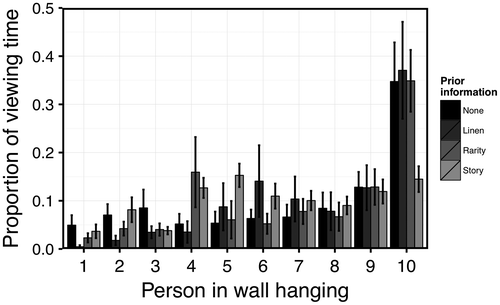
Our findings suggest that there may be something inherently interesting about this particular individual. Such an interest may result from the visual appearance of the human figure — perhaps he is in some way more salient than the other individuals — or from his positioning on the same wall as the door and the first person that observers will walk past as they enter the room. This individual is likely to be Jacob, and as such is an integral part of the story, but it is unlikely to be his role in the story’s narrative that made him interesting to our participants, because when they were informed about the narrative in the painted cloths this individual was no longer looked at more than the others. Rather, it would appear that alerting participants to the narrative in the painted cloths resulted in roughly equal amounts of time spent looking at each of the ten characters (although perhaps human figures and were not looked at as much as the others in this case).
Discussion
In summary, then, we found that both the previous experience and expertise of the participants and the information with which they were provided prior to entering the room influenced where people looked once inside the chamber. Those without previous knowledge of the cultural and historical significance of decorative textiles within historic spaces (that is, our non-expert group) spent no longer looking at the painted cloths than they did at furniture and objects within the room during their first entry (when given no information prior to entry). This finding suggests that the painted cloths did not inherently attract attention more than furniture or other objects, with profound implications for the status of ‘decorative art’. Given their scale and vivid visual quality (in terms of form and colour) it is surprising that they did not seem to receive more attention than other aspects of the room; it was only once information was provided to direct the participants to aspects of the painted cloths that these were looked at more than furniture or other objects. In contrast to our non-experts, the expert group spent more time looking at the painted cloths than they did at any other aspect of the room, even on their first entry when no information had been provided to direct them to these items. This result demonstrates the influence that previous knowledge has upon how people distribute their attention. Understanding the cultural and historical significance of the painted cloths is enough to profoundly influence how people viewed the contents of Queen Margaret’s Chamber.
Why might it be that non-experts did not look at the painted cloths as much as the experts? One possibility is that without previous knowledge of their significance, the walls and their coverings were effectively treated as part of the ‘background’ in the room by the non-experts. Laboratory-based studies of how people view images have suggested that participants spend more time looking at foreground objects than background, and are better able to detect unexpected changes to foreground than background in images.Footnote46 Indeed, recent research into the factors that guide viewing in images of scenes suggest that viewing strategies are likely to centre around objects in the depicted scenes,Footnote47 and studies of natural behaviour in real world environments show that the vast majority of time is spent viewing (task-relevant) objects in our surroundings.Footnote48 In our study, background elements such as the window, ceiling and floor were very rarely looked at by any of our participants. However, our data do not support the notion that the non-experts were essentially treating the wall coverings as part of the background: the painted cloths were looked at far more than the other background elements of the room such as the window, ceiling and floor, or indeed non-covered parts of the walls. Rather, the painted cloths were looked at for a similar amount of time to the furniture and other objects, suggesting that they had the status of objects in their own right.Footnote49 It is important to note that this result might be applicable only to the painted cloths in Queen Margaret’s Chamber. This particular textile scheme falls somewhere between overall pattern and narrative structure: the ‘narrative’ is not an obvious sequential arrangement of a series of scenes (as is often found, for example, in sets of Renaissance tapestries) but rather a slightly arbitrary arrangement of dislocated episodes. A more ordered series of pictorial scenes might result in a different amount and pattern of inspection by viewers.
For both our expert and non-expert viewers, being given information that directed attention to aspects of the painted cloths had a strong influence on viewing behaviour within the room. Whether directed toward the material, rarity, or narrative content of the cloths, both experts and non-experts spent the vast majority of time within the room looking at the painted cloths, with very little time spent looking at any other content of the room. The differences in overall allocation of attention between experts and non-experts that were found during the first entry to Queen Margaret’s Chamber was to a large extent absent once information about the painted cloths was presented to participants: only when the information focused on the materials from which the cloths were made did there appear still to be a difference, with experts looking for longer than non-experts at the painted cloths in these circumstances. For both groups of participants, prior information about the narrative of the depicted content of the painted cloths resulted in more time spent looking at them than any other type of information given. These results extend previous laboratory-based demonstrations that instructions and information provided to participants prior to viewing an image can influence how people view it.Footnote50 They show, for the first time, the profound effect that a range of different types of information given prior to viewing a real-world environment can have on the manner in which people explore it.
Expertise and information provided prior to room entry also influenced how attention was allocated within the cloths. For both experts and non-experts, as much time was spent looking at foliage (and, in the case of non-experts, background landscape) as was spent looking at people in the painted cloths. This result is surprising from a psychological and artistic point of view. Images of scenes depicting people within them typically result in more fixations directed toward the people than other content in these images, whether the scenes are depicted photographically or non-photographically.Footnote51 This result raises significant questions about the relationship between the elements of the textiles (and, indeed, of images more generally) that we would probably categorise as landscape or pattern, and pictorial or figurative subject matter. The landscape or pattern parts of an artistic work are often considered of secondary importance to the figures, and we tend to think of them as essentially a vehicle or setting. Our finding therefore apparently runs contrary to what might be expected in art-historical and psychological (or indeed biological and sociological) terms. Art history tends to classify artworks by subject matter and interpret through iconography, so this equal interest in other visual features might indicate the significance of form in visual art, no matter what the precise nature of the motif might be. However, our finding may be due to the composition of this particular set of cloths in which the narrative is not especially prominent and the balance of figures to background is less significant than in other schemes. Participants may not have been able to discern the presence of an obvious intended ‘narrative’ in the cloths at all compared to other forms of narrative presentation (such as a series of framed paintings in a gallery); or they may have understood them as being structured by the prominent framing design of the landscape features which pace and organise the narrative. This raises the possibility that people may negotiate these cloths as they do written narrative — as a combination of human action and contextual description. Further research could focus on a wider range of narrative scenes in different types of textile hanging to see whether this interesting finding is more widely applicable. It would also be important to establish the distinct ways in which participants interacted with different visual elements — did they move closer to the background in order to assess the quality of the cloth or painting, for instance, or to the figures in order to establish their facial features?
The attention paid to human figure is especially intriguing, and the nature of his appeal to viewers warrants some further consideration. This figure received more viewing time than any other for all conditions except for the situation in which participants were informed about the narrative content immediately prior to entering the room: in this case the time spent looking at 10 was similar to that spent looking at other figures. The character, probably intended to represent Jacob, certainly possesses a commanding presence within the room. His clothing is striking, with pale undergarments showing through his bright red outer garments, and he is framed by a large pale tree trunk immediately to the right of him. His beard and hat suggest an eminence which sets him apart from the other figures by stressing his authority, as does the gown which forms the top layer of his clothing. In addition, he appears to have been painted on a slightly larger scale than the other figures, although the same could also be said of Joseph (human figure 9), who accompanies him on this wall. The grouping of these two figures with the building above their heads, and the peak of the mountain above that, additionally frames them in a deliberate and significant gesture of greeting. The fact that only one of these figures received particular attention, however, suggests that viewers were not noticing the interaction between them, and were not therefore especially interested in trying to work out the narrative information the scene was intended to convey.
It is also important to note how the positioning of the figure of Jacob might affect participants’ engagement with it. It was possible to get much closer to some areas of the cloths than others as a result of the furniture contained within the room. Unlike Joseph, no part of Jacob was obscured behind the chest of drawers. Thus not only was the entirety of Jacob visible, but participants were able to approach closer to this figure than to many of the others. Given what we know from inventory evidence about the high numbers of pieces of furniture kept in chambers in this period, this must have been a common issue with such large-scale narrative textiles.Footnote52 It may suggest that the ability to view at close range encourages longer and more detailed viewing behaviour. His position just to the right of the fireplace made him the first figure that participants walked past and, perhaps more significantly, the last on their way out, which may itself have resulted in more time spent looking at this character than subsequently encountered figures. It is therefore unclear from the present data why Jacob was looked at so much more than the others in most conditions, and it could be any one or combination of several factors including: the low-level conspicuity of the figure (pale cloth contrasting with red outer garments, and red outer garments contrasting with surrounding green foliage), the size of the figure (being larger than others), the artistic depiction of his seniority, the artistic framing of this individual and his role in interaction with Joseph, or the physical placement of the figure within the room.
Implications for Historians and Heritage Professionals
An aim of this experiment was to identify the way in which individuals unfamiliar with the painted cloths or the room in which they were displayed inspected them in the first short period of their viewing. We hoped that our findings would inform us about the impact such textiles may have had on their original audiences. However, the strong influence on present-day viewers of both previous expertise and information provided prior to entry highlights the difficulty that we have as modern researchers in attempting to uncover how early modern individuals would have viewed these interiors.
Viewing behaviour is profoundly influenced by knowledge and goals when in an environment, and therefore, if we are to understand the manner in which early modern viewers would have viewed an environment, we must first comprehend (and indeed recreate) the knowledge and goals of those original viewers. In practice, of course, this is not possible in its entirety: we cannot strip away modern understanding and experience from participants, but we might be able to reconstruct aspects of the prior information that would have informed the viewing of domestic interiors in an early modern context. We need to pay attention to framing information, as even supposedly neutral viewing processes are subjective and open to manipulation. We should do so at a cultural level, with respect to the information which was in general social circulation with an intensity and volume that suggests it was brought to bear on interpreting such imagery — in other words, through print media and to a lesser extent sermons, plays and other public performances. We should also pay attention to the ways in which information circulated at the level of specific communities, investigating local social interactions that it might be possible to reconstruct and relate to particular decorative schemes.
It is likely that distinct groups of early modern viewers would have had very different levels of skill or familiarity with painted cloths such as those at Owlpen Manor; as we have seen in the present study varied understanding of the importance of decorative textiles in historic interiors is associated with very disparate viewing behaviour. In order to understand such inter-individual differences in early modern viewers, more work is needed to identify the social function of decorative textiles, the space and events in the context of which they are likely to have been viewed, and the expectations and resonances that both might raise. Doing so would, however, be contingent on the potential of future work to articulate the extent to which domestic interiors were similar to one another in the period, at the points on the social scale at which such textiles are likely to have been displayed — evincing a shared aesthetic language and set of priorities — or innovative and likely to create surprise. How familiar would friends, family and neighbours have been with this type of textile when they viewed it for the first time? How might the quality and duration of looking change or fade over repeated periods of time and daily exposure? At what point, if at all, might such furnishings stop being noticed?
As these findings indicate that the dynamic between image, narrative and material in early modern painted cloths is malleable and susceptible to manipulation, as such they also have implications for the interaction between audiences and decorative textiles in a museum or heritage setting. It is clear that different individuals will engage with historic material in very different ways depending upon their prior understanding, but providing information to viewers to some extent overrides these inter-individual differences, placing viewers on a more common ground for viewing the historic material. The strong effect of information provided to participants before entering the room highlights the impact that supporting material such as text provided alongside exhibits has upon the manner in which the viewer engages with historic spaces. It is, however, also worth noting the significant level of personal engagement which was involved in this process in our experiment — this was not a passive potential engagement with a textual label. If information directs attention so influentially when given sequentially, then it will be important to investigate ways of communicating with audiences that allow them to experience the same space sequentially in more complex ways: that is, by providing an opportunity to view an exhibit or space more than once, but with distinct information given before each viewing, the viewer can be directed to various aspects of historic spaces upon each viewing and thus build up a very different and deeper understanding and perception of the material than would be possible from a single encounter. This is very different to the process of, for instance, providing the kind of information about biblical stories which modern audiences may no longer bring into a space with them. Rather than trying to replicate early modern ways of seeing, such sequential presentation of information to audiences aims to develop a richer modern interaction with the relationship between textiles and the spaces in which they are displayed.
More work is now needed to further test, extend and refine the findings, and the ideas developed in these final sections, in relation to different participant groups and diverse kinds of decorative textiles within a domestic setting. Such further research should track body movements alongside eye movements, in order to understand how the latter correspond with the physical dynamics of the space. We observed, but did not measure, that individuals within the two groups of participants viewed the room and the cloths in very different ways, with some individuals spending a substantial amount of time in close proximity to the surface of the cloths. A sense of the distance from the objects viewed would be useful in telling us more about viewing in real-world environments, indicating particular strategies linked to the nature of participants’ interest and engagement. Understanding how eye and body movements together reflect degrees of knowledge and interest could have significant implications in museum and heritage practice because it could inform the development of modes of presentation that are visitor-led, so that generic interpretation would not be imposed on all visitors; instead gradations of tailored information could be prompted and initiated by the ways in which people move and look. Tracking movement will also suggest the routes the participants take around domestic spaces, linking ways of seeing to spatial interaction and offering opportunities to devise in an informed way visitor routes that direct attention to specific points of interest and deepen engagement with lived domestic experience as a result.
Appendix 1. Scientific Discussion of Method
Participants
Fourteen volunteers took part in this study. Seven were members of the AHRC-funded network ‘Ways of Seeing the English Domestic Interior, 1500–1700: The Case of Decorative Textiles’ and the other seven were undergraduate and postgraduate student volunteers.
Design
For each participant we varied the information provided before entering the room (no information, information about the material of the hangings, rarity information, narrative information) on each of their four entries to the room. In combination with the two differing groups of participants in terms of their background knowledge about the importance of decorative textiles in historic domestic interiors, our study therefore had a 4 (prior information) × 2 (participant group) experimental design. Here we refer to participants as experts if they have knowledge of the cultural and social significance of decorative textiles in historic domestic interiors (the network members) or non-experts if they have no specific knowledge about the cultural and social significance of decorative textiles in historic domestic interiors (the student volunteers).
Materials
The information provided before entering the room was in the form of sentences typed on cards. These statements highlighted the material from which the cloths were made, the rarity of the painted cloths and the story depicted on the painted cloths.
Eye Tracking
Participants’ eye movements were tracked using one of two Positive Science LLC mobile eye trackers, which allowed free head movement. Each tracker has two cameras mounted on the frame of a pair of spectacles (Fig. ): one records the scene from the participant’s point of view (scene camera), the other records movements of the right eye (eye camera). Data from the cameras were recorded using two camcorders housed in a waist pack or back pack worn by the participant.
The videos were later rendered using the Yarbus software provided by Positive Science LLC (Fig. ). Gaze direction was estimated using Yarbus, which tracks the pupil and corneal reflection. Calibration involved asking the participant to look at the centre of an experimenter’s palm, while the experimenter held it in front of his chest. Participants were asked to tilt their heads up and down then left to right, while they remained fixating on the thumb. Calibration was repeated after the task in order to check for tracker slippage during testing. Eye-movement data were collected at 30 Hz with a spatial accuracy of about 1 degree.
Procedure
Each participant was tested separately. First, the participant was escorted to a ‘set-up room’, adjacent to Queen Margaret’s Chamber. The eye tracker was set up and calibrated. The participant was informed that they would be required to enter and look around the experimental room four times. The participant was brought to the closed door of the room and instructed to step inside and look around for as long as they wished. Upon exiting the room, the door was closed and the participant was given an envelope with one of the information cards inside. They were asked to open the envelope, read the sentence on the card and hand back the card to the experimenter before re-entering the room. This procedure was then repeated twice, so that the participant had looked around the room four times and read all three of the information cards. The order in which the cards were supplied varied between participants to ensure that any difference in eye-movement behaviour between our information conditions was not due to familiarity with the room. Two of the six possible order combinations were used three times and the other four combinations were used twice. After the fourth visit to the experimental room the eye tracker was removed and the cameras turned off.
Analysis
Eye-tracking data were manually coded offline by the authors and two volunteer research assistants. Eye movements (saccades) were detected manually using deflections of the iris in the video overlay of the eye in the eye-tracking video.Footnote53 The minimum detectable saccade size using this method was 0.5–1 degree. There was no minimum fixation duration criterion. Manual coding involved noting fixation locations for the first minute (1,800 frames) of each viewing of the experimental room. For any fixations away from the painted cloths the coders simply noted the item the participant was looking at or the area (for example, ‘Floor’ or ‘Ceiling’) if no item was fixated. Fixations on the painted cloths were divided into several categories. Any looks to leaves or trees were coded as ‘Foliage’ and looks to the mountains or sky were labelled ‘Background’. The human figures were numbered 1–10, the buildings were numbered 1–3 and the animals were coded by name. As well as fixations on the figures and objects depicted in the painted cloths, looks to the ‘Edge’ of the painted cloths and the ‘Top edge’ were coded.
There were three main levels to our analysis of the coded data. Firstly, we analysed how much time participants spent looking at different aspects of the room and how this varied across our between- and within-subjects conditions. Secondly, we analysed the variations in looks within the painted cloths only. Finally, we focused on fixations to the human figures depicted in the cloths.
All analyses were run as mixed design analyses of variance (ANOVAs) using the ezANOVA function in the ez package for the R statistical programming environment.Footnote54 In all analyses participant group was included as a between-subject factor and prior information (from the statement read before entering the room) was included as a repeated measures factor. For significant effects, generalised eta-squared (η2G) is reported as a measure of effects size. Significant interactions are broken down using Bonferroni corrected t-tests.
Acknowledgements
We are extremely grateful to Nicholas Mander, the owner of Owlpen Manor, for supporting the network, hosting this experiment (requiring considerable upheaval to his home) and for permission to feature these cloths and represent his research, published most recently as N. Mander, ‘The painted cloths at Owlpen Manor, Gloucestershire’, in N. Costaras and C. Young eds, Setting the Scene: European Painted Cloths from the Fourteenth to the Twenty-First Century (London: Archetype Publications, 2013), pp. 24–32.
Additional information
Notes on contributors
Benjamin W. Tatler
Benjamin W. Tatler is a Professor of Psychology at the University of Aberdeen. He is a vision scientist and cognitive psychologist who researches how people use their eyes to gather visual information from the world around them in order to aid the on-going behaviour. His work is particularly focused on vision and cognition in real world settings. He is co-author of Looking and Acting (Oxford University Press, 2009) with Professor Michael Land FRS, and The Moving Tablet of the Eye: The Origins of Modern Eye Movement Research (Oxford University Press, 2005) with Professor Nicholas Wade FRSE, and has published over fifty peer-reviewed articles and chapters on eye movements and visual perception.
Ross G. Macdonald
Ross G. Macdonald is a Postdoctoral Researcher in the Department of Computational Linguistics and Phonetics at Saarland University. He is a cognitive psychologist who specialises in social attention, language and eye-tracking methods. He is the author of several journal articles and conference papers on these subjects.
Tara Hamling
Tara Hamling is Senior Lecturer in History at the University of Birmingham. She is an art historian with a particular interest in the decorative arts and religious context of early modern Britain. She is author of Decorating the Godly Household: Religious Art in Post-Reformation Britain (Yale University Press, 2010) and editor (with Richard L. Williams) of Art Re-formed: Reassessing the Impact of the Reformation on the Visual Arts (Cambridge Scholars Publishing, 2007) and (with Catherine Richardson) of Everyday Objects: Medieval and Early Modern Material Culture and its Meanings (2010).
Catherine Richardson
Catherine Richardson is Reader in Renaissance Studies at the University of Kent. She studies the literature and history of early modern material culture, and has written books on Domestic Life and Domestic Tragedy in Early Modern England (Manchester University Press, 2006), Shakespeare and Material Culture (Oxford University Press, 2011) and, with Tara Hamling, A Day at Home in Early Modern England, The Materiality of Domestic Life, 1500–1700 (Yale University Press, forthcoming, 2016).
Notes
1 It is clear from documentary evidence that decorative textiles were the most ubiquitous form of domestic furnishing in early modern England, but few survive and the extant objects present significant challenges for research, interpretation, conservation, display and presentation (such as condition, vulnerability to damage and surface deterioration caused by light and touch).
2 See, for example, E. Bachta, R. J. Stein, S. Filippini Fantoni and T. Leason, Evaluating the Practical Applications of Eye Tracking in Museums (Online, 2012). Available from: http://www.museumsandtheweb.com/mw2012/papers/evaluating_the_practical_applications_of_eye_t [Accessed: 12 June 2015]; and S. Filippini Fantoni, K. Jaebker, D. Bauer and K. Stofer, Capturing Visitors’ Gazes: Three Eye Tracking Studies in Museums (Online, 2013). Available from: http://mw2013.museumsandtheweb.com/paper/capturing-visitors-gazes-three-eye-tracking-studies-in-museums/ [Accessed: 12 June 2015].
3 For painted cloths in England, see F. E. Matley Moore, ‘Painted cloths’, Transactions of the Worcestershire Archaeological Society, 3rd series, viii (1982), pp. 73–79 and, placed in a wider context, N. Mander, ‘Painted cloths: history, craftsmen and techniques’, Textile History, xxviii, no. 2 (1997), pp. 119–48. The most recent and comprehensive study of the history of painted cloths is N. Costaras and C. Young eds, Setting the Scene: European Painted Cloths from the Fourteenth to the Twenty-First Century (London: Archetype Publications, 2013).
4 Genesis 37: 1–36.
5 N. Mander, ‘The painted cloths at Owlpen Manor, Gloucestershire’, in Costaras and Young eds, Setting the Scene, pp. 24–32. The cloths have been cut down slightly in places, but their current display maintains the scale of the imagery in the room.
6 See T. Hamling and C. Richardson, A Day at Home in Early Modern England: The Materiality of Domestic Life, c.1550–c.1650 (Newhaven: Yale University Press, forthcoming, 2016).
7 B. Erdmann and R. Dodge, Psychologische Untersuchungen über das Lesen auf experimenteller Grundlage (Halle: Niemeyer, 1898).
8 This calculation assumes a (general) central window of high-quality vision with a diameter of around four degrees of visual angle. Thus the central window occupies π(4/2)2 degrees2, which is approximately 0.03 per cent of the solid angle of a sphere, 4π(180/π)2, centred around the eye to represent the entire three-dimensional visual environment.
9 G. T. Buswell, How People Look at Pictures: A Study of the Psychology and Perception in Art (Chicago: Chicago University Press, 1935).
10 M. Land and B. W. Tatler, Looking and Acting: Vision and Eye Movements in Natural Behaviour (Oxford: Oxford University Press, 2009); B. W. Tatler, M. Hayhoe, M. Land and D. H. Ballard, ‘Eye guidance in natural vision: reinterpreting salience’, Journal of Vision, xi, no. 5 (2011), article no. 5, pp. 1–23; N. J. Wade and B. W. Tatler, The Moving Tablet of the Eye: The Origins of Modern Eye Movement Research (Oxford: Oxford University Press, 2005).
11 C. N. McAllister, ‘The fixation of points in the visual field’, Psychological Review Monograph Supplements, vii, no. 1 (1905), pp. 17–53.
12 T. Foulsham and G. Underwood, ‘What can saliency models predict about eye movements? Spatial and sequential aspects of fixations during encoding and recognition’, Journal of Vision, viii, no. 2 (2008), article no. 6, pp. 1–17; D. J. Parkhurst, K. Law and E. Niebur, ‘Modeling the role of salience in the allocation of overt visual attention’, Vision Research, xlii, no. 1 (2002), pp. 107–23; P. Reinagel and A. M. Zador, ‘Natural scene statistics at the centre of gaze’, Network: Computation in Neural Systems, x, no. 4 (1999), pp. 341–50.
13 A. L. Yarbus, Eye Movements and Vision (New York: Plenum Press, 1967).
14 W. Einhäuser, M. Spain and P. Perona, ‘Objects predict fixations better than early saliency’, Journal of Vision, viii, no. 14 (2008), p. 18; B. W. Tatler, R. J. Baddeley and I. D. Gilchrist, ‘Visual correlates of fixation selection: effects of scale and time’, Vision Research, xlv, no. 5 (2005), pp. 643–59.
15 C. H. Judd, ‘The Muller-Lyer illusion’, The Psychological Review: Monograph Supplements, vii, no. 1 (1905), pp. 55–81.
16 Buswell, How People Look at Pictures; Yarbus, Eye Movements and Vision.
17 K. Humphrey and G. Underwood, ‘Domain knowledge moderates the influence of visual saliency in scene recognition’, British Journal of Psychology, c, no. 2 (2009), pp. 377–98.
18 Land and Tatler, Looking and Acting.
19 E. M. Reingold and N. Charness, ‘Perception in chess: evidence from eye movements’, in G. Underwood ed., Cognitive Processes in Eye Guidance (Oxford: Oxford University Press, 2005), pp. 325–54.
20 T. Donovan and D. Litchfield, ‘Looking for cancer: expertise related differences in searching and decision making’, Applied Cognitive Psychology, xxvii, no. 1 (2013), pp. 43–49.
21 Z. Kapoula, G. Daunys, O. Herbez and Q. Yang, ‘Effect of title on eye-movement exploration of cubist paintings by Fernand Léger’, Perception, xxxviii, no. 4 (2009), pp. 479–91.
22 Tatler, Hayhoe, Land and Ballard, ‘Eye guidance in natural vision’.
23 B. W. Tatler, ‘The central fixation bias in scene viewing: selecting an optimal viewing position independently of motor biases and image feature distributions’, Journal of Vision, vii, no. 14 (2007), p. 4.
24 U. Leonards, R. Baddeley, I. D. Gilchrist, T. Troscianko, P. Ledda and B. Williamson, ‘Mediaeval artists: masters in directing the observers’ gaze’, Current Biology, xvii, no. 1 (2007), pp. R8–R9.
25 B. W. Tatler and M. F. Land, ‘Vision and the representation of the surroundings in spatial memory’, Philosophical Transactions of the Royal Society B: Biological Sciences, ccclxvi, no. 1564 (2011), pp. 596–610; B. W. Tatler and S. L. Tatler, ‘The influence of instructions on object memory in a real-world setting’, Journal of Vision, xiii, no. 2 (2013), p. 5; B. W. Tatler, Y. Hirose, S. K. Finnegan, R. Pievilainen, C. Kirtley and A. Kennedy, ‘Priorities for selection and representation in natural tasks’, Philosophical Transactions of the Royal Society B: Biological Sciences, ccclxviii, no. 1628 (2013), 20130066.
26 A. Kingstone, D. Smilek and J. D. Eastwood, ‘Cognitive ethology: a new approach for studying human cognition’, British Journal of Psychology, xcix, no. 3 (2008), pp. 317–40; Land and Tatler, Looking and Acting.
27 Land and Tatler, Looking and Acting.
28 Studies of the so-called ‘great rebuilding’ of the housing stock, traditionally associated with the period 1560–1640 but generally acknowledged as a regionally piecemeal process over a longer timeframe, have pointed towards the division and extension of space and identified shifts in the nature of decoration from, for example, halls and parlours to chambers. More work is needed, however, to connect ‘sequential’ narrative scenes with physical movements and lines of sight within specific spatial conditions. On these issues, see the discussion of the scheme of wall painting in the parlour at Little Moreton Hall, Cheshire, and the plasterwork ceiling at Lanhydrock House, Cornwall, in T. Hamling, Decorating the Godly Household: Religious Art in Post-Reformation Britain 1560–1660 (New Haven and London: Yale University Press, 2010), pp. 134–37 and 182–92.
29 See, for example, on site-specific performance, S. Bennett and M. Polito eds, Performing Environments (Basingstoke and New York: Palgrave Macmillan, 2014); on sensory approaches to drama, see, for example, H. Dugan, ‘Shakespeare and the senses’, Literature Compass, vi, no. 3 (2009), pp. 726–40 and J. Gil Harris, ‘The Smell of Macbeth’, Shakespeare Quarterly, lviii, no. 4 (2007), pp. 465–86.
30 Data were analysed using a 2 × 4 ANOVA (2 participant groups: expert, non-expert; 4 types of information provided: none, material, rarity, narrative).
31 F(1,12) = 0.10, p = .757.
32 F(3,26) = 13.53, p < .001, η2G = .294.
33 F(3,36) = 0.78, p-.515.
34 3-way ANOVA (participant group: expert, non-expert; prior information: none, material, rarity, narrative; category of room content: painted cloths, furniture and objects): main effect of prior information, F(3,36) = 14.50, p < .001, η2G = .140; main effect of category of content, F(2,24) = 346.08, p < .001, η2G = .793; interaction between participant group and category of content, F(2,24) = 6.87, p = .004, η2G = .076; interaction between prior information and category of content, F(6,72) = 14.08, p < .001, η2G = .355; 3-way interaction, F(6,72) = 2.24, p = .048, η2G = .088.
35 1-way ANOVA for non-expert group: F(2,12) = 1.86, p = .197.
36 1-way ANOVA for expert group: F(2,12) = 17.08, p < .001, η2G = .740; t-tests to follow-up: cloths vs. furniture: t(12) = 4.98, p < .001; cloths vs. objects: t(12) = 4.33, p = .003.
37 1-way ANOVA for expert group: F(3,18) = 19.49, p < .001, η2G = .765; follow-up t-tests to compare between statements given prior to room entry for experts: narrative vs. rarity: t(12) = −3.68, p = .019; narrative vs. material: t(12) = −4.99, p = .002; narrative vs. no information: t(12) = −11.29, p < .001. 1-way ANOVA for non-expert group: F(3,18) = 3.42, p = .040, η2G = .363; follow-up t-tests for non-experts: narrative vs. material: t(12) = −3.73, p = .017; narrative vs. no information: t(12) = −3.42, p = .030.
38 For experts: t(12) = −4.45, p = .005.
39 3-way ANOVA (participant group: expert, non-expert; prior information: none, material, rarity, narrative; content of painted cloth). Main effect of content of painted cloth, F(6,72) = 50.87, P < .001, η2G = .566.
40 Interaction between content of painted cloth and participant group, F(6,72) = 5.35, p < .001, η2G = .137; interaction between content of painted cloth and prior information, F(18,216) = 4.37, p < .001, η2G = .150.
41 Foliage: t(54) = −3.18, p = .017; people: t(54) = −2.46, p = .121.
42 Background: t(54) = 2.94, p = .034; edges: t(54) = 4.18, p < .001.
43 1-way ANOVAs to look at effects of content of painted cloth for each type of prior information. Top border: F(3,39) = 5.63, p = .003, η2G = .302; vertical edges: F(3,39) = 5.39, p = .003, η2G = .293; people: F(3,39) = 10.17, p < .001, η2G = .439.
44 3-way ANOVA (expertise x prior information x figure in painted cloth). Main effect of figure within cloth: F(9,108) = 13.13, p < .001, η2G = .221.
45 Interaction between prior information and figure in painted cloth : F(27,324) = 1.45, p = .072, η2G = .077.
46 K. Rayner, X. Li, C. C. Williams, K. R. Cave and A. D. Well, ‘Eye movements during information processing tasks: individual differences and cultural effects’, Vision Research, xlvii, no. 21 (2007), pp. 2714–26; R. A. Rensink, J. K. O’Regan and J. J. Clark, ‘To see or not to see: the need for attention to perceive changes in scenes’, Psychological Science, viii, no. 5 (1997), pp. 368–73.
47 A. Nuthmann and J. M. Henderson, ‘Object-based attentional selection in scene viewing’, Journal of vision, x, no. 8 (2010), article no. 20, pp. 1–19.
48 Land and Tatler, Looking and Acting.
49 See the Introduction to this special issue, Catherine Richardson and Tara Hamling, ‘Ways of Seeing Early Modern Decorative Textiles’, for the distinctions between modern and early modern notions of background.
50 Yarbus, Eye Movements and Vision.
51 E. Birmingham, W. F. Bischof and A. Kingstone, ‘Get real! Resolving the debate about equivalent social stimuli’, Visual Cognition, xvii, nos 6–7 (2009), pp. 904–24; Yarbus, Eye Movements and Vision.
52 For further information about the typical furnishing of early modern rooms, see C. Richardson, Domestic Life and Domestic Tragedy: The Material Life of the Household (Manchester: Manchester University Press, 2006), chapter 2.
53 For details see M. F. Land and D. N. Lee, ‘Where we look when we steer’, Nature, ccclxix, no. 6483 (1994), pp. 742–44.
54 M. A. Lawrence, Ez: Easy Analysis and Visualization of Factorial Experiments. R Package Version 4.2–2 (Online, 2013). Available from: http://CRAN.R-project.org/package=ez [Accessed: 13 December 2015]; R Core Team, R: A Language and Environment for Statistical Computing. R Foundation for Statistical Computing. Vienna, Austria (Online, 2014). Available from: http://www.R-project.org/ [Accessed: 13 December 2015].

